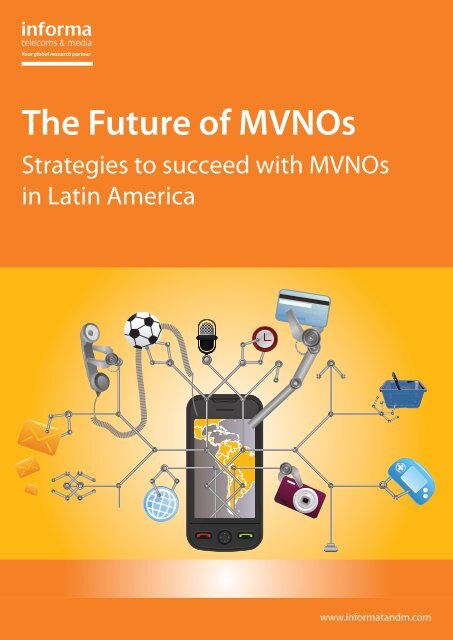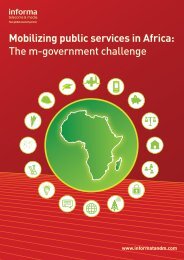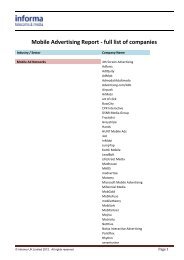The Future of MVNOs - Informa Telecoms & Media
The Future of MVNOs - Informa Telecoms & Media
The Future of MVNOs - Informa Telecoms & Media
Create successful ePaper yourself
Turn your PDF publications into a flip-book with our unique Google optimized e-Paper software.
ContentsAbout the authors......................................................................................................... 3Understanding the global picture ............................................................................. 4<strong>The</strong> outlook for <strong>MVNOs</strong> in Latin America .................................................................. 4Opportunity for MVNO-led pricing arbitration is low.................................................. 5Triple play will remain a major MVNO driver ............................................................ 6Beyond the “telecoms MVNO”: <strong>The</strong> retailer, the financial and the youth MVNO....... 7<strong>The</strong> MVNO quadrant: Global and regional case studies.............................................. 8Global MVNO survey .................................................................................................... 10© <strong>Informa</strong> UK Limited 2012. All rights reserved.<strong>The</strong> contents <strong>of</strong> this publication are protected by international copyright laws, database rights and other intellectual property rights. <strong>The</strong> owner <strong>of</strong> these rights is <strong>Informa</strong> UK Limited,our affiliates or other third party licensors. All product and company names and logos contained within or appearing on this publication are the trade marks, service marks or tradingnames <strong>of</strong> their respective owners, including <strong>Informa</strong> UK Limited. This publication may not be:-(a) copied or reproduced; or(b) lent, resold, hired out or otherwise circulated in any way or form without the prior permission <strong>of</strong> <strong>Informa</strong> UK Limited.Whilst reasonable efforts have been made to ensure that the information and content <strong>of</strong> this publication was correct as at the date <strong>of</strong> first publication, neither <strong>Informa</strong> UK Limited norany person engaged or employed by <strong>Informa</strong> UK Limited accepts any liability for any errors, omissions or other inaccuracies.Readers should independently verify any facts and figures as no liability can be accepted in this regard - readers assume full responsibility and risk accordingly for their use <strong>of</strong> suchinformation and content.Any views and/or opinions expressed in this publication by individual authors or contributors are their personal views and/or opinions and do not necessarily reflect the views and/oropinions <strong>of</strong> <strong>Informa</strong> UK Limited.2© 2012 <strong>Informa</strong> UK Ltd. All rights reserved. www.informatandm.com
About the authorsDario TalmesioPrincipal AnalystDaniele TricaricoSenior AnalystDario Talmesio, a principal analyst with <strong>Informa</strong> <strong>Telecoms</strong>& <strong>Media</strong>, leads the Mobile Europe team, focusing on marketdevelopments and competitive dynamics <strong>of</strong> the Europeanmarkets. He advises European mobile operators in keyareas <strong>of</strong> their business including competitive issues, marketand marketing positioning, MVNO and retail strategies, newbusiness models, and FMC and FMS strategies.Dario began his analyst career at the Economist Group’sEconomist Intelligence Unit, where he focused on the energyand telecoms markets in Western European countries.Before joining <strong>Informa</strong>, he worked for the Yankee Group asan EMEA mobile consumer analyst based in London.Dario holds a degree in Business and Economics from theUniversita Cattolica <strong>of</strong> Milan and an MA in Applied Socialand Market Research from the University <strong>of</strong> Westminsterin London.Daniele Tricarico is a senior analyst covering LatinAmerica at <strong>Informa</strong> <strong>Telecoms</strong> & <strong>Media</strong>. He examinesoperator strategies with a focus on operator performance,mobile networks and service strategies, including VASand <strong>MVNOs</strong>. He regularly writes in-depth analysisand reports, and contributes to bespoke research andconsulting projects in the region. Daniele has alsodeveloped a series <strong>of</strong> international conferences ontelecoms networks and infrastructure, such as the IMS2.0World Forum, the SDP Global Summit and the FemtocellsForum.Prior to joining <strong>Informa</strong>, Daniele worked as a socialmedia analyst for consulting firm Interaction London.Fluent in English, Spanish and Italian, Daniele holds anMA from the University <strong>of</strong> Bologna and an MSc in newmedia and information systems from the London School<strong>of</strong> Economics.Follow Dario on Twitter @dariotalmesioFollow Daniele on Twitter @dtricaricoWorking with <strong>Informa</strong><strong>Informa</strong> <strong>Telecoms</strong> & <strong>Media</strong>’s strategic insights, key market data and forecasts have led the market for more than 25 years. Wehave 65 analysts in nine research <strong>of</strong>fices <strong>of</strong>fering pragmatic and actionable advice to the leading global players in the telecomsand media sector. Our clients represent all parts <strong>of</strong> the value chain, from telecoms operators to pay-TV providers, from contentproviders to device manufacturers. Our syndicated research and comprehensive databases provide vital data and analysisfocusing on the global telecoms and media markets, and are widely used and valued by industry pr<strong>of</strong>essionals and thoughtleaders. We also provide a range <strong>of</strong> consultancy and bespoke research services, including white papers, webinars, strategysessions and executive presentations.For more details on <strong>Informa</strong> <strong>Telecoms</strong> & <strong>Media</strong> and how we can help your company identify future trends andopportunities, please contact Marco Esposito, marco.esposito@informa.com or +44 (0) 7884 400 999.© 2012 <strong>Informa</strong> UK Ltd. All rights reserved. www.informatandm.com 3
licenses to the insurance company Porto Seguro andthe VoIP provider Sermatel Comercio. Both companieshave teamed up with second-placed operator TIM, whichprovides the network infrastructure, and Datora, amobile-virtual-network enabler (MVNE). More recently,Anatel granted the first pure MVNO license to the MVNESisteer. Besides TIM, other network operators are lookingwith interest at the MVNO model, for example, the marketleader Vivo. In March, Vivo announced plans to have atleast two MVNO partners by the end <strong>of</strong> 2012. In orderto achieve its objective, the operator created a boardfor wholesale and MVNO operations and is currentlyanalyzing proposals from around 30 potential partners.<strong>The</strong> Latin American MVNO market started picking up inthe second half <strong>of</strong> 2011, and the strongest activity wasin Colombia and Chile. In February this year, Chileanregulator Subtel received 26 license applications fromcompanies interested in launching MVNO operations. InApril, Virgin Mobile Latin America (VMLA) inauguratedits first MVNO in the Andean country, targeting theyouth and “youthful” segments with a simple portfolio <strong>of</strong>prepaid data packages and a small but attractive range<strong>of</strong> smartphones.So far, VMLA is the only international group with plans tolaunch MVNO operations across the region. In additionto Chile, it plans to launch in Brazil, Colombia, Mexico,Argentina, Peru, Uruguay and Bolivia. Interestingly,Colombia is likely to have eight <strong>MVNOs</strong> and three MNOsin operation by the end <strong>of</strong> 2012: In addition to the <strong>MVNOs</strong>already in operation, retailers Exito and Falabella, andfixed operator Emcali, have also started discussions t<strong>of</strong>ind an MNO partner.Opportunity for MVNO-ledpricing arbitration is low<strong>MVNOs</strong> must find ways to <strong>of</strong>fer attractive data<strong>of</strong>fers – to the right niche and at the right priceIn traditional MVNO markets, such as Europe, NorthAmerica and Asia, <strong>MVNOs</strong> have historically targetedthe prepaid market with a low-cost proposition andthen tried to attract the more affluent customers.International experience shows that the wholesalebusiness can bring MNOs significantly higher EBITDAmargins than retail, by reducing subscriber-acquisitioncost (SAC) while only slightly lowering ARPU. Typically,a market with comparatively high or very high pricesis more likely to have room for MVNO-led pricearbitration. Markets with higher levels <strong>of</strong> churn alsomight <strong>of</strong>fer better opportunities for <strong>MVNOs</strong> becauseusers are more inclined to switch providers (see fig. 3).Churn (%)Fig. 3: Selected countries, blended churn, 3Q10-3Q114.03.53.02.52.01.5Argentina Brazil Colombia MexicoFrance UK US3Q104Q101Q112Q113Q11Fig. 2: Latin America, selected <strong>MVNOs</strong>' subscriptions,4Q10-4Q11Source: <strong>Informa</strong> <strong>Telecoms</strong> & <strong>Media</strong>Uff250MaxcomUNE EPMTelecsaGiven their pricing environments and churn trends,Brazil, Mexico and Colombia, and to a lesser extentArgentina, would appear well-suited for additionalSubscriptions (000s)2001501005004Q101Q112Q113Q114Q11price competition. In all the markets, the lack <strong>of</strong>regulation in mobile termination rates (MTRs) and thefact that operators have mostly been left to negotiateMTRs among themselves have resulted in the highercost <strong>of</strong> <strong>of</strong>f-net calls. Brazilian rates are also affectedby high telecoms-services taxation and, as a result,the country has the highest SMS prices in the region.Promotional activity, primarily the <strong>of</strong>fering <strong>of</strong> cheapon-net calls, is strong across the region, contributingSource: <strong>Informa</strong> <strong>Telecoms</strong> & <strong>Media</strong>to sustained high levels <strong>of</strong> multiple-SIM ownershipand churn.© 2012 <strong>Informa</strong> UK Ltd. All rights reserved. www.informatandm.com 5
<strong>Informa</strong>, however, believes that for Latin AmericanMNOs the option <strong>of</strong> teaming up with low-cost <strong>MVNOs</strong>to bring price competition to other MNOs is notparticularly attractive. In the prepaid-dominated LatinAmerican markets, the potential negative impact <strong>of</strong>low-cost <strong>MVNOs</strong> on an already flat or declining ARPUis a major concern for MNOs. Latin American MNOswill be more interested in teaming up with <strong>MVNOs</strong>that, although helping improve EBITDA margins, canalso bring additional revenues from unaddressedniches willing to use incremental airtime and dataservices (see fig. 4).Fig. 4: Selected operators, EBITDA margin, 3Q11Margin (%)50403020100Movistar(Argentina)Claro(Brazil)TIM(Brazil)Source: <strong>Informa</strong> <strong>Telecoms</strong> & <strong>Media</strong>Telcel(Mexico)<strong>Informa</strong> also believes that pricing will be crucial to thesuccess <strong>of</strong> the higher-value data <strong>MVNOs</strong>. In additionto the well-known benefits <strong>of</strong> the MVNO model,higher-value data-focused <strong>MVNOs</strong> can help provideincremental revenues to <strong>of</strong>fset declining ARPUlevels. Finding the correct pricing levels and models,however, is a tough task. As in the case <strong>of</strong> VirginMobile in Latin America, data <strong>MVNOs</strong> will be eagerto add smartphones to their data plans, but withoutsubsidies it can be challenging to meet customerdemand for the devices at the right price.At the same time, <strong>MVNOs</strong> must be able to negotiategood wholesale rates from MNOs for the data they thensell at retail. In the retail market, MNOs are movingaway from flat rates and toward models where theycharge by actual data consumption, by time or by accessto selected apps. MNOs themselves are still strugglingto find efficient ways to price data services in the retailmarket. When it comes time to negotiate wholesaledata prices, <strong>MVNOs</strong> face the risk <strong>of</strong> remaining stuckwith unfavorable conditions, which could ultimatelyjeopardize their business model.Orange(France)Vodafone(UK)AT&T(US)Triple play will remain amajor MVNO driverChallenging fixed-line operators and ISPsshould exploit the MVNO model to develop morecompetitive <strong>of</strong>feringsMost <strong>of</strong> the early Latin American <strong>MVNOs</strong> have been drivenby the opportunity to <strong>of</strong>fer fixed/mobile bundles, especiallyin the most concentrated markets, such as Mexico andColombia (see fig. 5). It is not a coincidence that despitethe absence <strong>of</strong> a full regulatory framework, both Movistarin Mexico and Tigo in Colombia have taken advantage <strong>of</strong>existing rules allowing telecoms services to be resold tobuild MVNO partnerships with ISPs and cable players. Toerode shares <strong>of</strong> strong competitors in their respectivemarkets, Movistar and Tigo have established <strong>MVNOs</strong>with fixed operators looking to add value to their bundles<strong>of</strong> voice, TV and Internet service by including mobility.Movistar was the first to pursue this strategy, when itteamed up with Maxcom at the start <strong>of</strong> 2008. Similarly, Tigoin Colombia has partnered with ISPs UNE EPM and ETB to<strong>of</strong>fer mobile broadband services to contract customers.For the foreseeable future, <strong>Informa</strong> expects alternativeISPs, especially in the most unbalanced fixed-linemarkets, to retain a strong interest in the MVNOmodel with the aim <strong>of</strong> increasing customer loyaltyFig. 5: Brazil, Argentina, Colombia, Mexico, marketshare and concentration, 3Q111009080706050403020100Market share (%)America Movil Telefonica Millicom Telecom ItaliaTelecom Personal Oi Others*BrazilArgentinaConcentration: Herfindahl indexColombiaMexico0.25 0.32 0.51 0.54Notes: <strong>The</strong> Herfindahl index is defined by the sum <strong>of</strong> the squares <strong>of</strong> themarket shares <strong>of</strong> all firms in the market, where the market shares areexpressed as fractions. An index below 0.01 indicates a highly competitivemarket. An index below 0.15 indicates an unconcentrated market. Anindex between 0.15 and 0.25 indicates moderate concentration. An indexabove 0.25 indicates high concentration. *Nextel, CTBC and Sercomtel InBrazil; Iusacell and Nextel in Mexico; and Nextel in Argentina. TelecomItalia owns 22.9% <strong>of</strong> Telecom Personal in Argentina.Source: <strong>Informa</strong> <strong>Telecoms</strong> & <strong>Media</strong>6© 2012 <strong>Informa</strong> UK Ltd. All rights reserved. www.informatandm.com
and reinforcing their <strong>of</strong>fering by bundling products.With their knowledge <strong>of</strong> and expertise in the telecomsbusiness, fixed-line players and ISPs remain the mostlikely candidates to buy into the MVNO model at theearly stages <strong>of</strong> its development.It is no coincidence that the first cable operator tolaunch an MVNO was Megacable in Mexico and that thechallenger fixed-line operator Axtel is also said to beclose to launching an MVNO there. <strong>The</strong> opportunity iscomparatively weaker in countries where the broadbandmarket is more competitive, such as Brazil, and the mainexisting mobile operators can develop converged <strong>of</strong>fersthrough partnering with their own fixed-line counterparts.In markets like Brazil, it is the nontelecoms companiesthat are expected to be major players in the MVNObusiness, starting with retailers and financial institutions.Beyond the “telecomsMVNO”: <strong>The</strong> retailer, thefinancial and the youth MVNORetailers can help MNOs increase loyalty andreduce churn, but negotiations with MNOs willbe toughBeyond the “telecoms MVNO” (e.g., an existing fixed-linetelecoms player with an MVNO operation), retailers andfinancial institutions have been and remain among thestrongest candidates to become <strong>MVNOs</strong> in Latin America(see fig. 6). Large and mass-market retailers arealready key players in the value chain, since they takeFig. 6: Brazil, companies interested in launching an MVNO<strong>Telecoms</strong>FinancialGVT, Lebara, Virgin MobileBanco do Brasil, Banco RealSantander, Itau, HSBCthe largest slice <strong>of</strong> handset sales, especially for prepaidusers. <strong>The</strong> combination <strong>of</strong> a strong brand and a largerand far-reaching retail network are the key benefitsretailer <strong>MVNOs</strong> could <strong>of</strong>fer MNOs.Despite the clear benefits that retailers could bring toMNOs, only a handful <strong>of</strong> international retailers, such assupermarket chains Tesco in the UK and Aldi in Germany,have launched <strong>MVNOs</strong>. Retailers are typically focused onvolumes, have low EBITDA margins and are used to havingstrong negotiating and bargaining power with suppliers,factors that can prove to be especially challenging intheir negotiations with MNOs. Furthermore, retailers willnaturally target the mass market, which for MNOs raisesthe risk <strong>of</strong> market-share cannibalization, especially in theprepaid-dominated Latin American markets.Even so, the retailer model does have potential in theregion, starting in the geographically larger countries,such as Brazil, Mexico and Argentina, where it is morechallenging for MNOs to develop far-reaching retailnetworks. In addition, retailers can help MNOs increaseloyalty and reduce churn by using their customer-loyaltyexperience to <strong>of</strong>fer discount and loyalty cards and to<strong>of</strong>fer leasing programs for device purchases. As theVAS market develops, the retail MVNO is also in a goodposition to develop mobile commerce.<strong>The</strong> m-commerce and m-banking opportunity, alongsidethe retail network, is at the core <strong>of</strong> the potential valueproposition <strong>of</strong> the financial MVNO. <strong>The</strong> opportunityfor this type <strong>of</strong> MVNO varies across Latin America,depending on the level <strong>of</strong> maturity <strong>of</strong> each market. <strong>The</strong>reis certainly scope in the region for prospective ethnic<strong>MVNOs</strong>, targeting communities <strong>of</strong> migrants and nationalswith family or friends living abroad to provide financialservices. Given the reach and needs <strong>of</strong> the Latin Americandiaspora in Europe and North America, the long-distancemarket <strong>of</strong>fers a good opportunity to add mobile-moneyvalue-added services (VAS), such as international credittransfers, to voice services.RetailSportsOthersCarrefour, Casas Bahia,Pao de Acucar, WalmartSao Paulo FC, Santos FC,S.E. Palmeiras, Gremio FBPA,Corinthians, CR Vasco de GamaCorreios, Ipiranga, GloboSources: Sisteer, Datora, <strong>Informa</strong> <strong>Telecoms</strong> & <strong>Media</strong>Overall, banking penetration remains on average lowerthan mobile penetration, and telecoms and financialregulators are starting to develop rules for the provision<strong>of</strong> mobile-money VAS to those both with and without bankaccounts. A number <strong>of</strong> providers <strong>of</strong> financial serviceshave already launched m-banking platforms and couldbe interested in the MVNO model. Since smartphonepenetration remains about 10% regionally, the MVNOopportunity is initially expected to be limited mainly to© 2012 <strong>Informa</strong> UK Ltd. All rights reserved. www.informatandm.com 7
<strong>of</strong>fering voice and basic SMS-enabled financial servicesfor low-end and feature phones, but as smartphoneprices decline, more sophisticated services will appear.<strong>The</strong> financial MVNO, however, faces the samechallenges as the retailer MVNO in terms <strong>of</strong> negotiationswith MNOs, given its natural focus on the mass market.In addition, operators are increasingly eager to playa role in the m-commerce and m-banking markets.<strong>The</strong> way regulation develops in this area will largelydetermine the development <strong>of</strong> this MVNO model.Regardless <strong>of</strong> market-structure barriers to <strong>MVNOs</strong>, giventhe current demographic trends, <strong>Informa</strong> believes thatthose <strong>MVNOs</strong> targeting the youth segment have a largeraddressable market in Latin America than in Europe andNorth America (see fig. 7). Nonetheless, the size <strong>of</strong> theaddressable market for youth <strong>MVNOs</strong> will depend on theincome levels and local competitive dynamics in eachcountry. In the case <strong>of</strong> Virgin Mobile Latin America, forexample, the flexibility <strong>of</strong> pricing models will determine thereal size <strong>of</strong> the youth segment addressable in countriesas different as Chile and Bolivia, especially when <strong>MVNOs</strong>plan to <strong>of</strong>fer unsubsidized devices. <strong>The</strong> strength <strong>of</strong> theopportunity for the youth MVNO will also vary depending onother factors, such as changing regulation. For example,with Brazil planning to cut taxes for tablets manufactured inthe country, there might be an opportunity for data-focused<strong>MVNOs</strong> targeting the devices to the youth segment.Fig. 7: Global, estimates <strong>of</strong> under-15 populationpercentage, end-2010Under-15 population (%)35302520151050Source: UNCaribbeanCentral AmericaSouth AmericaNorth AmericaEastern EuropeNorthern EuropeSouthern EuropeEastern Europe<strong>The</strong> MVNO quadrant: Global and regional case studies<strong>The</strong> viability <strong>of</strong> <strong>MVNOs</strong> depends on local market conditions – and on the will and ability <strong>of</strong> operators to reach out to niches<strong>of</strong> customers with highly relevant services. <strong>Informa</strong> presents a selection <strong>of</strong> mini case studies <strong>of</strong> international and regionalcompanies that have succeeded with the MVNO model.<strong>The</strong> incumbent MNOOrange, FranceOrange, part <strong>of</strong> the France Telecom Group, supportsseveral <strong>MVNOs</strong> in France, its home market, including:• Virgin Mobile, which recently incorporated twoquad-play <strong>of</strong>ferings and is regarded as one<strong>of</strong> the most thriving full <strong>MVNOs</strong> globally. Itssubscriptions totaled more than 2 million atthe end <strong>of</strong> 2011.• <strong>The</strong> M6 MVNO <strong>of</strong> Metropole Television,the third most-watched TV network in thecountry.• NRJ Mobile, a 90/10 joint venture betweenbanking corporation Credit Mutuel-CIC andmultimedia group NRJ. Like Virgin Mobile,NRJ targets the youth segment. It had 900,000subscribers at the end <strong>of</strong> 2011.ICE, Costa RicaBefore the mobile market was liberalized in late 2011,state-owned ICE launched two <strong>MVNOs</strong> to preemptmoves by new competitors Claro and Movistar. ICEpartners with well-established Costa Rican companiesto reinforce its role and image as a key asset for thecountry. ICE’s network currently supports two <strong>MVNOs</strong>,both with 45,000 subscribers as <strong>of</strong> April 2011:• Fullmovil is owned by Grupo Virtualis, aconsortium formed by consumer electronics,household appliance and furniture retailersGrupo Monge and Casa Blanca.• Tuyo Movil is owned by national TV stationTeletica. <strong>The</strong> first MVNO to launch in CostaRica, it has achieved positive results in bothquality and customer experience.8© 2012 <strong>Informa</strong> UK Ltd. All rights reserved. www.informatandm.com
<strong>The</strong> challenger MNOE-Plus, GermanyGerman operator E-Plus has been owned by Dutchtelecommunications operator KPN since 2002. E-Plus’network enables a range <strong>of</strong> affiliated <strong>MVNOs</strong>, includingpan-European MVNO Simyo, which is also presentin Belgium, France, the Netherlands and Spain, andsupermarket retail MVNO Aldi Talk, both leading theno-frills prepaid German market. E-Plus also enablesethnic MVNO Ay Yildiz, targeted at the large Turkishexpat community, as well as blau.de, MedionMobile,MyMTVMobile and Base. Its advanced and diversifiedMVNO strategy has been instrumental in allowingE-Plus to maintain its market share at just under 20%,making it the third-largest operator in Germany.Movistar, MexicoTelefonica in Mexico was one <strong>of</strong> the Latin Americanpioneers in the MVNO space, hosting one <strong>of</strong> the firstregional <strong>MVNOs</strong>, by fixed-line operator Maxcom, backin 2008. In recent quarters, Telefonica has consolidatedits MVNO strategy. In July 2011, Megacable launchedMegacel on Movistar’s network with the plan <strong>of</strong> targetingexisting fixed-line clients by <strong>of</strong>fering multiple SIMs t<strong>of</strong>amily households at preferential rates. At the end <strong>of</strong>2011, Movistar was announced as the MNO partner forVirgin Mobile in Mexico. As a challenger operator in amarket where America Movil has a dominant presence,MVNO enablement has become an important strategictool for Movistar in an effort to gain market share.<strong>The</strong> MVNOPoste Mobile, ItalyPoste Mobile, the MVNO <strong>of</strong> national postal servicePoste Italiane, is the most significant player in theItalian MVNO market, with various voice and data<strong>of</strong>fers, mobile phone deals and a large distributionnetwork. It <strong>of</strong>fers a host <strong>of</strong> VAS, primarily m-bankingand m-payment, such as airtime remittances, couponclick-to-buy and m-insurance. Poste Mobile recentlylaunched the Zero Pensieri Infinito service plan, whichincludes unlimited voice calls and SMS messages to allnational destinations plus 1GB <strong>of</strong> data for a monthly fee<strong>of</strong> €34 (US$44). Poste Mobile is also a rare example <strong>of</strong>an MVNO marketing services specifically to businesscustomers. Hosted on the network <strong>of</strong> second-placedVodafone, it has more than 2 million subscriptions.Uff, ColombiaUff was launched in late 2010 by TV network RCNTelevision, a unit <strong>of</strong> media conglomerate Ardila Lullegroup. Uff has a no-frills business model based on<strong>of</strong>fering cheap long-distance calls to the main countrieswhere the Colombian diaspora lives. Hosted on Tigo’snetwork, Uff rapidly added 50,000 subscriptionsin its first two months, reaching a total <strong>of</strong> 250,000subscriptions by the end <strong>of</strong> 2011 and becoming thefirst sizable MVNO in Latin America. From launch, theMVNO has evolved its service proposition by adding twoprepaid data plans and two BlackBerry plans. Througha strategic agreement with Nokia, it also <strong>of</strong>fers the“Pack Listo Uff” plan, including a Nokia C3 device withunlimited data.<strong>The</strong> MVNETeleena, Netherlands/UKTeleena is a mobile virtual network enabler (MVNE)based in the Netherlands and the UK that provides anarray <strong>of</strong> services on a wholesale basis to <strong>MVNOs</strong> andcorporate customers, including low-cost roaming andconverged fixed/mobile applications. <strong>The</strong> companyis focused on enabling <strong>MVNOs</strong> to differentiatethemselves through <strong>of</strong>fering VAS. Teleena owns andoperates its own BSS/OSS and an all-IP mobile corenetwork, which is connected to Vodafone’s radioaccess network in the Netherlands. In Europe, Teleenahas a partnership with Vodafone in the UK and theNetherlands, where it hosts over a dozen <strong>MVNOs</strong>.Datora Telecom, BrazilDatora was the first telecoms company to apply for anMVNO license from telecoms regulator Anatel in Brazil.This license enabled Datora to become the first MVNOaggregator (MVNA) in the country. <strong>The</strong> company hasinternational expertise in both connecting operatorsusing VoIP and infrastructure management. It is currentlyenabling the country’s second-placed MNO, TIM Brasil,and insurance company Porto Seguro to launch the firstMVNO in Brazil. Datora has also signed an agreementwith Virgin Mobile to launch operations in the country. <strong>The</strong>company has a strong focus on the machine-to-machine(M2M) opportunity in Latin America.© 2012 <strong>Informa</strong> UK Ltd. All rights reserved. www.informatandm.com 9
Global MVNO surveyRespondents: 145Respondent company types: <strong>MVNOs</strong>, MVNEs, MNO wholesalers, IT and telecoms vendorsDate: March-April 2011Which MVNO types <strong>of</strong>fer the biggest growth potential? (Choose two)"Ethnic and retail segments are still big, but new segments are emerging"4035302520151050Ethnic/internationalYouth/media andentertainmentSocial networksRetail/brand extenderDevice/machineto-machine<strong>Telecoms</strong> discountEnterpriseShare <strong>of</strong> respondents (%)What are the top business challenges for <strong>MVNOs</strong>? (Choose two)"<strong>The</strong> MVNO target market will remain price-sensitive; diversification might be needed"• <strong>MVNOs</strong> will focus more on customer-experience management.• Data connectivity will enable diversification in products and services.• But price pressure will remain challenging.50Share <strong>of</strong> respondents (%)403020100Price competitionServicediversificationTechnologymanagementCustomersegmentationRetail distributionBilling and cashmanagementDevice managementWholesale-contractterms10© 2012 <strong>Informa</strong> UK Ltd. All rights reserved. www.informatandm.com
Which non-telecoms industries could benefit from MVNO services? (Choose two)"<strong>The</strong> MVNO business model will support vertical sectors’ core business"• <strong>Media</strong> and entertainment companies could benefit from the MVNO business model.• <strong>The</strong> financial-services industry is emerging as a sector that could benefit from <strong>MVNOs</strong>.• Connected-device firms and social networks are also potential beneficiaries.6050403020100Which service features could improve MVNO <strong>of</strong>ferings? (Choose two)"An explosion <strong>of</strong> data <strong>of</strong>ferings is imminent"• Three main developments are expected, all customer-centric:° ° Customer loyalty° ° Data° ° Financial services.40Share <strong>of</strong> respondents (%)3020100Financial (remittances,payment and transfers)International roamingMobile broadbandCloud-based apps (telephony,messaging, backup)Social CRM/self careDynamic pricingMobile advertisingLoyalty programsConsumerelectronicsAutomotive<strong>Media</strong> andentertainmentFinancial servicesShare <strong>of</strong> respondents (%)Social networksOther© 2012 <strong>Informa</strong> UK Ltd. All rights reserved. www.informatandm.com 11
ABOUT INFORMA TELECOMS & MEDIA<strong>Informa</strong> <strong>Telecoms</strong> & <strong>Media</strong> is the leading provider <strong>of</strong> business intelligence and strategic marketing solutions toglobal telecoms and media markets.Driven by constant first-hand contact with the industry, our 65 analysts and researchers produce a range <strong>of</strong>intelligence services including news and analytical products, in-depth market reports and datasets focused ontechnology, strategy and content.For more details on <strong>Informa</strong> <strong>Telecoms</strong> & <strong>Media</strong> and how we can help your company identify future trends andopportunities, please contact:Marco Esposito<strong>Informa</strong> <strong>Telecoms</strong> & <strong>Media</strong>Direct: +44 (0) 207 017 5853Mobile: +44 (0) 7884 400 999Email: marco.esposito@informa.com24/7 access to business-criticalinsight, analysis and datawww.informatandm.com/icCutting edge information on all fixedline, cable and broadband marketswww.informatandm.com/wbisKeeping the world’s leading cellularorganisations better informedwww.informatandm.com/wcisconnectJoin us on LinkedIn:www.informatm.com/linkedinFollow us on Twitter:www.twitter.com/informatmEmail us:marketing.enquiries@informa.comSubscribe to our Connect emailwww.informatm.com/connect© 2012 <strong>Informa</strong> UK Ltd. All rights reserved. www.informatandm.com 1











